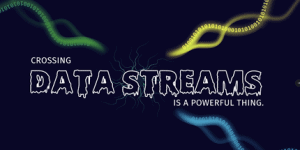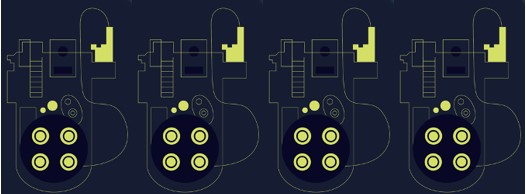
Harnessing data streams — joining both batch and real-time events — empowers data scientists and analysts to address sophisticated problems.
Individual streams provide data related to a particular dimension — the price of a stock, the order of a customer, the metric of a device. Analytics and applications can be served by a single stream of data, but uses are narrow and local.
Crossing streams unveils grander possibilities, ones filled with history, context, and related signals. When our Ghostbuster heroes (Venkman and the gang) needed to rise to the challenge (and defeat Mr. Stay Puft), they joined forces—and streams! The whole was greater than the sum of the parts.
In our community, data scientists, analysts, and developers are similarly called to action. Harnessing data streams — joining both batch and real-time events — empowers you to address sophisticated problems. And, as with Venkman, sometimes you need others to bring their gear and help. Here are four vital components to making the crossing of streams successful:
1) Bring together data, use cases, and people.
Accelerating innovation, maximizing efficiency, and providing flexibility are established priorities for sophisticated data systems. A nimble, evolving software backbone realizes these goals. Open-source core components provide the long-term agility and interoperability paramount for success.
Tools evolve, and sometimes you need to use that new ghost trap.
2) Future-proof your data stack with open-source formats.
Data portability has long been a sacred requirement for enterprise data teams. Walled gardens create future debt, and vendor lock-in has an unspoken long-term cost, one often paid in business drag. Store data using open formats.
CSV and JSON have been big for years, with Avro, Protobuffs, Parquet, Orc, and others recently gaining popularity. They have respective reasons to exist, but each is principled on the delivery of structured data to a plethora of independent systems, agnostic to and oblivious of the computer science downstream.
As the magnitude of data has scaled and the related financial and latency cost of moving data has compounded, the concept of open data now includes in-memory formats, not just the kind that persisted on disk. It is now often unacceptable to require data to be copied, moved, serialized, or translated in any way. In particular, Apache Arrow’s significant community benefits from its ability to serve in-memory data to a range of data processing libraries across many languages with minimal overhead, zero-copy reads, and fast access at scale.
But let’s remember, in Ghostbusters, the data was just the start of the adventure.
3) Make joining real-time and static data a fundamental requirement.
A modern data engine must bring together data from a variety of sources. The jargon of warehouse, lake, and the centaur-like lakehouse are now common imagery. However, the growing popularity of event streams is a not-so-quiet canary suggesting static data is no longer the whole story.
Data changes. Modern workloads live in a state of flux. Real-time data matters.
Data engines and processing libraries must be architected to address and move fluidly between real-time and static data workloads. “Continuous intelligence” is a trendy phrase for systems that combine the context of history with the event signals of the moment. Modern data systems should be built to process real-time data, event streams, and other updates as a first-class competency. These should be core strengths, not add-ons, not afterthoughts.
After all, as we learned in Ghostbusters, Gatekeepers and Key Masters are a lot less powerful until they are joined together.
4) Always put the user first.
Today’s data users have a variety of skills, tools, workflows, and priorities. Coalescing a team around a shared platform serves the individual while energizing the team. Data systems that maximize individuals’ efficiency and foster collaboration drive business value.
Open data software lights the way. The intriguing mix of cooperation and competition in open projects yields an unrivaled pace of progress and ingenuity. Organized to encourage interoperability, community development promises enhancements, integrations, and user experience upgrades. Popular paths become paved roads. Such systems make users an army of one while supporting the codependent work product required for any even moderately complex use case.

After all, one proton pack is powerful, but four working together is invincible.
I ain’t ‘fraid of no ghost.





























